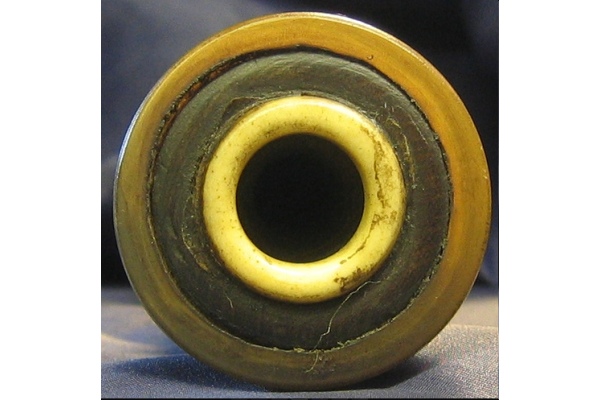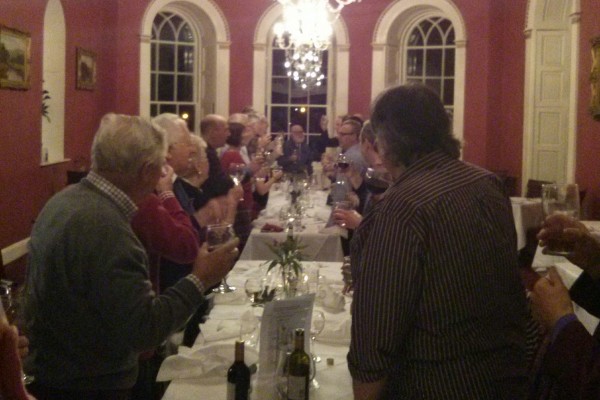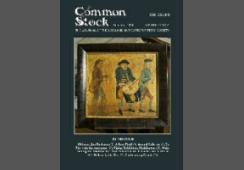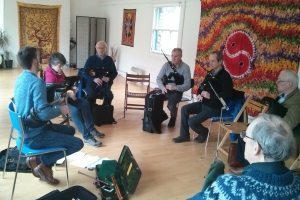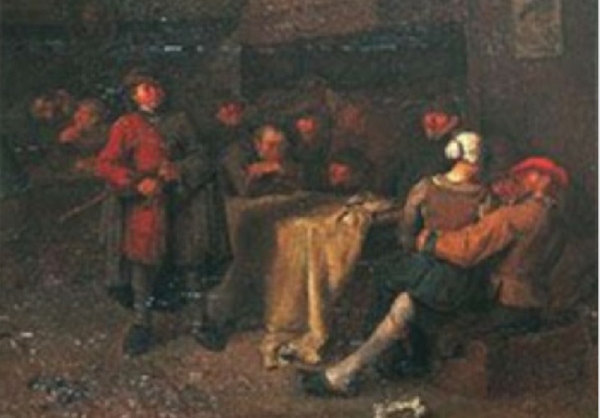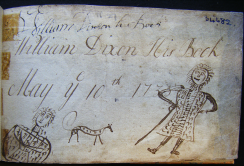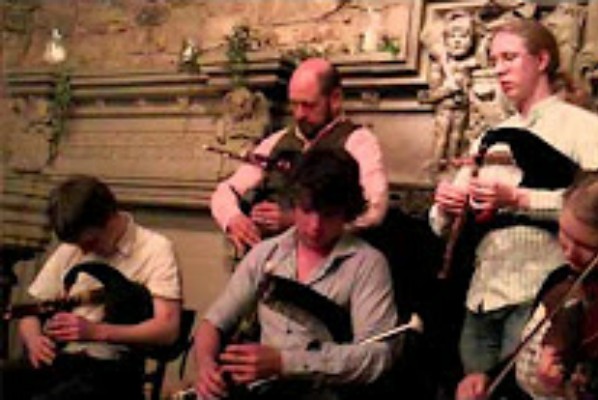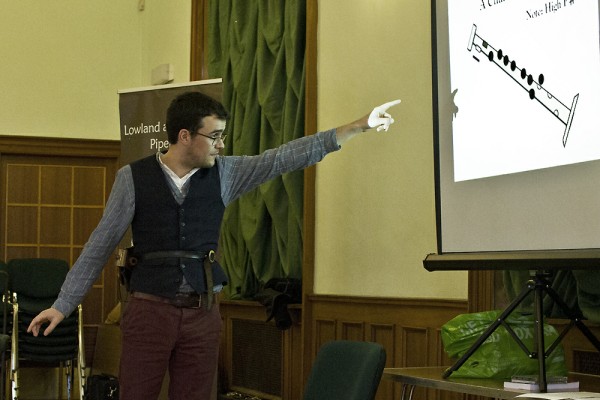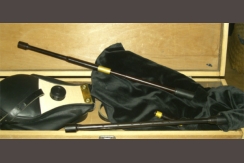Two traditions divided by a Common repertoire
One of an occasional series of explorations of the repertoire turns out to be more complicated than this title suggests
Go to Berwick Johnny has been a staple in the repertoire of pipers from the beginning of the revival when Gordon Mooney first published it. However, when Matt Seattle produced his edition of the William Dixon Manuscript, pipers were in for a surprise. Dixon’s version of the tune, titled Berwick Bully, was apparently set in the ‘seven finger’ key. All the other settings of this tune would be played by pipers in the ‘six-finger’ key. Dixon alone has the first three of each strain’s four bars based on the seven-finger note; only the final bar is in accord with the drone. Matt himself describes this tune as being in G with a scale in the Lydian mode, and this might be true in theory, but when I’m playing it I cannot hear it any other way than that the final bar is the ‘X’ one (using Matt’s System) and all the others the ‘Y’ or ‘Away’ ones. Whichever way it is described, it is certainly a setting that captures the attention, especially of those who are familiar with the tune’s more common settings.

Playing this tune again recently, I realised that this harmonic structure was in fact equivalent to that in the first strain of Dixon’s tune ‘Dorrington’. That tune, however, goes on to be harmonically more sophisticated. Trying to understand more about how Dixon’s version came about, and how it relates to the larger history of the tune turned up another surprise, a feature which in my experience is unique in music manuscripts. (Since I wrote this Matt has pointed me to another example, which may feature in another issue.)
The earliest appearance of the tune is in Henry Atkinson’s fiddle manuscript from Northumberland, dated 1695, where it is titled ‘The New Road to Berwick’. It is notated in the key of F; this was to become the most frequently used key:

The first page of the tune in Atkinson’s manuscript
It is revealing to compare this with Dixon’s setting when written out on the conventional stave, ‘starting one note lower’ as Dixon says in a note; they look remarkably similar, until we notice the absence of the Bflat symbol that appears in Atkinson’s version.

William Dixon’s setting as it appears in the manuscript
Closer examination reveals another difference, however. The harmonic structure of Atkinson’s is XYXX, Dixon’s is YYYX (or XXXY if we see it as being in the Lydian mode). Here is the whole of Atkinson’s setting: [Note that each of the seven strains has an ‘equivalent’ in Dixon’s setting, though the order is different.]
 I
I
The New Road to Berwick, Henry Atkinson MS. 1695
In earlier articles in this series, it has been suggested that one difference between Scottish and Northumbrian versions of a tune is in this question of where in the four harmonic sections the variant comes (usually bar 2 or 4). However, here we have both possibilities in Northumbrian versions. What happens in the Scottish versions?
The earliest Scottish settings come from around the same period as each other; Margaret Sinkler’s fiddle and keyboard manuscript is dated 1710, and the setting in the Gairdyn Manuscript is located between pages dated 1700 and 1710. As we shall see, there is evidence that Gairdyn’s is the later of the two. But the really unusual thing about these two manuscript settings is that in both, the first strain has only 6 bars, of which the harmonic structure is XYXXXY.
Closer inspection of the Sinkler manuscript setting reveals that there are two ‘extra’ bars at the end. Here are the opening and closing staves of the manuscript

Before we consider the significance of this, it’s worth noting that the same thing occurs in the Gairdyn manuscript setting. Here are the first two strains, almost, but not quite, the same as Sinkler’s. Note that bar 2 uses the same group of three G’s as Atkinson, an idea unique to these two sources.

And here are the final closing staves; here the extra two bars are written after the final repeat sign and before the closing flourish

Here is a transcription of the whole tune from Sinkler’s manuscript

Berwick Johny as it appears in Margaret Sinkler’s manuscript, Glasgow, 1710
And here is the tune in the Gairdyn manuscript:

Gairdyn as in MS [note values corrected in Strain 6, bars 1 & 3; the original has q sq sq etc.; see the manuscript excerpt above]. The crosses indicate some kind of ‘beat’ or doubling, a reminder that there are three beats in the bar, not two.
Before we consider the significance of this we need to look at one more example. However, before doing that, it’s worth asking which of these settings is the earliest? Is one copied from the other? Both Gairdyn’s and Sinkler’s (the first compiled in Edinburgh(?), the second in Glasgow) are so closely related to Atkinson’s that it’s difficult not to assume they have a common source, though there are several small differences; however the difference in interpretation of the penultimate strain, with Gairdyn’s notation errors, suggests that it was copied from the Sinkler, or Sinkler’s source. And the manner in which the first strain of the two later settings starts by echoing Atkinson’s XYXX structure and then adds the two last bars suggests that the original source matched that of Atkinson. (Note also Gairdyn’s change to the opening bar of strain 4.)
Or so it would seem, until we encounter our next Scottish version, published in James Oswald’s Caledonian Pocket Companion, book 6, some time around 1745.

Oswald, Caledonian Pocket Companion, Book 6, c.1745
Oswald’s version is in G, and he opens with the first six bars in XYXXXY format, but then reverts to the XXXY structure which persist through (with the exception of the penultimate strain, as is the case with the other two settings). Oswald does not use repeats or even double bar lines, but otherwise his setting is more or less a replica (though not an exact one) of the other two, apart from the omission of strain 4. It was presumably chance that resulted in Oswald laying out the extra two bars in the same way as Gairdyn did.

Go to Berwick Johny, from a manuscript said to have been written by David Young, c.1760 in Edinburgh; it appears to be a cross between the three earliest manuscripts, including the six bar opening strain and two bars at the end. Note that there is no Bflat in the key signature. Compare this to Dixon’s version above.
So what are we to make of this unusual arrangement? All three early Scottish sources match; the opening strain is XYXXXY but the last two bars are missing; subsequent strains are XXXY; Atkinson’s setting is XYXX throughout. One might speculate that one or other of the earliest Scottish scrievers worked from the same source as Atkinson for the first strain but their convention could not sustain it and resorted to the device of adding the last two bars at the end, the motive being, presumably, that thereby they created a ‘circular’ setting, sending the player back to the opening, and maintaining an XXXY structure. An interesting idea, compounded, perhaps by Oswald and Young omitting any strain ending-marks. I am grateful to Matt for pointing out that David Young did the same thing with his setting of Wallington (again, a Scot writing a Northumbrian tune).
The tune continued to be included in manuscripts and publications throughout the 18th century, mostly with selections of two or three of the strains from these early setting strains. However, towards the very end of the century a new strain appears. The earliest setting I have found is in a manuscript of James Miller of Perth (described as being ‘for the fife’), dated 1799.

Go to Berweck Jockey James Miller MS. Perth, 1799 (for the fife)
In the second part of the Complete Repository (1799), Neil Gow printed a two-strain version. In part 4 (1839), however, a further two strains were included:

Exactly what Gow intended by his comment ‘Jig time’ is unclear; he certainly intended the 3/2 time signature to be read as three beats in the bar, judging by the accompaniment. Elsewhere in the book he labels tunes as ‘a reel’ or ‘a jig’; perhaps ‘jig time’ was intended as an indication of tempo. (The text above the last stave says the tune was printed in the 2nd Part but the last two parts were ‘omitted’.}
By the middle of the 19th century the tune had found its way into manuscripts from fiddlers south of Northumberland, most of them including this new strain: Here is one from William Clerke of Norfolk that has it in first place:

Berwick Jockey, Wm Clarke MS Feltwell, Norfolk 1858
Perhaps the strangest of these late 18th-early 19th century settings ‘Y gŵr a'i Farch’ (The man and his horse), included in Edward Jones’ Musical, Poetical and Historical Relicks of the Welsh Bards, published in 1802. Described as ‘An old welsh Jig’, Jones informs us it is ‘usually danced in North Wales, by five persons’.

And so it might be, though Cameron thought it a ‘Scotch Air’

‘A Scotch Air’ from Cameron’s Selection of Violin Music, 1859
It will have been obvious that none of these versions are for pipes, all having a range of a 10th or more. Not till the manuscript of Robert Bewick (written out between 1835 & 1843) does an eight-note setting appear, though Bewick had the possibility of a wider range and many tunes in his manuscript employ it.

Berwick Johnny, Bewick manuscript 1835-1843
From Bewick onward the tune persisted in the Northumbrian tradition, as indeed it must have done from William Dixon onward, for it was still in circulation in the 1920’s when Thomas Clough’s version of Berwick Billy was included in the Clough family manuscripts.

The manuscript itself (written on graph-paper) has a few peculiarities. The rhythm of the first and second strains is swapped so that the first strain opens with a semiquaver-quaver- dotted quaver pattern, and the second strain with three quavers, and this feature persists through the two strains. Also each strain is written with the last note of the previous strain as a ‘pick-up’, and the final bar has five crotchets, what should be the final note appearing as a pick-up at the beginning; the sign DC (back to the beginning) appears above the last crotchet, reinforcing the suggestion that this is a continuous aural tradition, including the notion implied by the early settings, that the tune is to be played continuously.
We have come quite a way from our original question as to why Dixon set his tune in the unique manner he did; by now it should be clear, however, that in 1733 the tune appears to have been solely a fiddle tune; in creating a nine-note version Dixon had two options for handling the second strain; the first was the one employed by Bewick a hundred years later (and indeed suggested by both Matt in the ‘pre-Dixon’ setting he included in his Border Bagpipe Book and Gordon Mooney in his Collections), to drop down a semi-tone or a tone for the second note in the motif in order to avoid the high b, a note which Bewick had but Dixon clearly did not. This alone should prove that he was playing a chanter that did not overblow even this one note. His second option was a radical one - to set the whole tune a tone down. This device had consequences in other strains and required a deal of ingenuity to re-model them. Dixon was well up to the task, and his version remains unique, ‘a great surprise’, as Matt describes it in his notes to the tune in The Master Piper.

Go to Berwick Johnny, from The Scots Musical Museum Vol. 6
